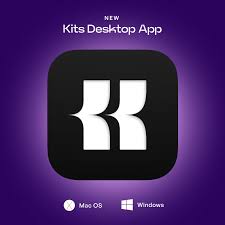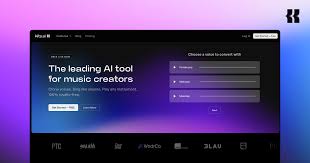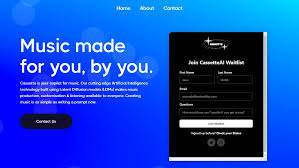If you've tried OpenAI Jukebox, you already know it was an ambitious leap in AI-generated music—capable of producing raw audio that mimicked real artists and genres. But it also had major limitations: long processing times, lack of interactivity, no interface, and difficult-to-control output.
So if you’re wondering, what is the alternative to OpenAI Jukebox, you’re not alone. The good news is that several modern, more accessible AI music generators have emerged, offering faster generation, better audio quality, vocal support, and user-friendly interfaces. Let’s break down the best options available today, based on how they compare to Jukebox in creativity, control, and output quality.

Why People Are Moving Beyond OpenAI Jukebox
OpenAI Jukebox was groundbreaking in 2020 for directly generating music as raw audio, not just MIDI or symbolic formats. It could simulate the voice of artists and generate full tracks with lyrics. But in practice, using it was complicated:
The codebase was massive and required GPUs not accessible to most users
There was no official interface or web app
Output took hours to generate
Control over composition was minimal, especially for structure and lyrics
This led to the rise of more practical alternatives. Let’s dive into the top AI music tools that now outperform Jukebox in usability and results.
Top 5 Real Alternatives to OpenAI Jukebox
Suno AI
Best for: Full songs with vocals and instrumentals generated from text prompts
Why it's better than Jukebox:
Simple interface: Just enter lyrics or a description, and it creates a complete song
High-quality vocals: Realistic AI voices that fit your genre prompt
Fast generation: Typically takes under 60 seconds
Remixable output: You can regenerate variations
Suno allows users to create radio-quality tracks with rich vocals, unlike Jukebox’s often-garbled audio samples. You don’t need coding skills or GPU access—just type, click, and play.
Free plan available with limited generations per day.
Website: https://suno.com
Udio AI
Best for: Structured songs and remixing with precision
Why it stands out:
Edit and control structure: Modify chorus, verse, and genre directly
Lyric-to-music pipeline: Converts your words into natural-sounding vocals
Broad genre support: From hyperpop to lo-fi jazz
Udio offers more compositional control than Jukebox ever did. Users can split songs into sections, adjust length, and remix different segments. It’s especially good if you're building music for storytelling or game soundtracks.
Website: https://www.udio.com
Riffusion
Best for: Real-time music loops with a creative twist
Unique approach:
Generates music using text-to-spectrogram diffusion
Visual and interactive process
Loopable, ambient, and genre-specific soundscapes
While Riffusion doesn’t create full songs with vocals like Jukebox, it excels in experimental audio generation. Ideal for content creators and developers seeking unique sound beds.
Website: https://www.riffusion.com
AIVA (Artificial Intelligence Virtual Artist)
Best for: Instrumental music for film, games, and advertising
Advantages over Jukebox:
Fully structured musical composition (MIDI and score-based)
Supports classical, cinematic, and jazz
Offers downloadable sheet music and editing tools
Unlike Jukebox, which outputs audio, AIVA composes editable music files. If you're a producer looking for precise structure and genre accuracy, AIVA is your go-to tool.
Website: https://www.aiva.ai
Boomy
Best for: Instant song creation and streaming distribution
Why it's worth considering:
Choose a genre, hit generate, and tweak as needed
Automatically mixes and masters your track
Publish directly to Spotify and earn royalties
Boomy provides one of the easiest ways to create and share music—even distributing your AI tracks to major platforms. It’s less about deep customization and more about accessibility and reach.
Website: https://boomy.com
Comparison: OpenAI Jukebox vs. Modern Alternatives
| Feature | OpenAI Jukebox | Suno AI | Udio AI | Riffusion | AIVA | Boomy |
|---|---|---|---|---|---|---|
| Vocal Support | Yes (limited) | Yes | Yes | No | No | Yes |
| Genre Control | Limited | Strong | Strong | Moderate | Precise | Basic |
| Interface Available | No | Yes (Web) | Yes (Web) | Yes (Web) | Yes (Web) | Yes (Web) |
| Speed | Hours | Seconds | Seconds | Seconds | Seconds | Seconds |
| Commercial Use | Not practical | Limited Free | Limited Free | Yes | Paid | Yes |
| Structure Control | Minimal | Moderate | High | Low | Full | Low |
Who Should Use Which Tool?
Songwriters & vocalists: Use Suno AI or Udio AI
Filmmakers & game devs: Try AIVA for soundtracks
Content creators: Use Riffusion for sound beds or Boomy for fast creation
Musicians seeking structure: AIVA or Udio AI provide more creative control
FAQ: Common Questions About OpenAI Jukebox Alternatives
Q1: Can I still use OpenAI Jukebox?
Technically yes, but it requires serious hardware and coding skills. There’s no live web interface hosted by OpenAI anymore.
Q2: Is there a direct download or API for Suno or Udio?
Both platforms offer web interfaces. API access is currently restricted or invite-only.
Q3: Are these tools truly free?
Most offer free versions with limited generation. For regular or commercial use, subscriptions range from $10–$30/month.
Q4: Which AI music generator sounds most realistic?
Currently, Suno AI and Udio AI lead in realistic vocal performance and production quality.
Q5: Can I monetize the music I create with these tools?
Yes—especially with Boomy and Mubert (not listed above). Always check licensing terms.
Final Thoughts
So, what is the best alternative to OpenAI Jukebox? The answer depends on what you're trying to create. If you're after realistic vocals and easy song generation, Suno AI and Udio AI have clearly taken the lead. For instrumental and compositional depth, AIVA is a top-tier pick. And for loop-based or visual experimentation, Riffusion opens up a new kind of creativity.
In short, Jukebox may have laid the foundation, but today's tools are far more usable, accessible, and impactful for music creators at every level.
Learn more about AI MUSIC








